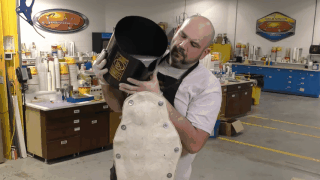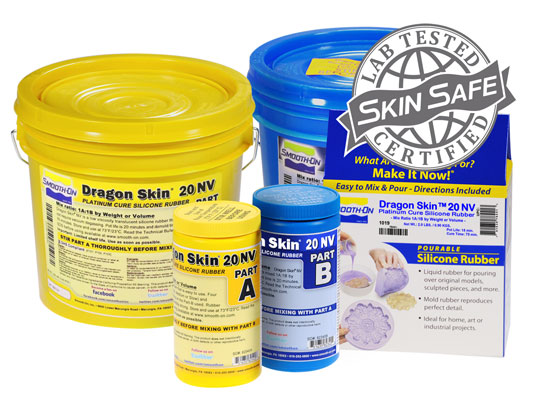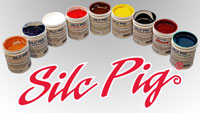Dragon Skin™ 20 NV
Dragon Skin™ NV Series silicones are easy to use translucent platinum silicones that are mixed 1A:1B by volume (no weighing scale necessary). They feature very low viscosities and vacuum degassing is not required for most applications.
Features
Mold Making: Dragon Skin™ NV silicones are ideal for making fast set, strong molds suitable for casting wax, gypsum, resins and more.
Skin Effects (SFX): Dragon Skin™ silicones are used around the world to make spectacular skin and creature effects. Cured Dragon Skin™ NV silicones are skin safe and certified by an independent laboratory. They are an excellent choice for casting into alginate molds for making realistic body part props. An infinite number of color effects can be achieved by adding Silc Pig™ or Ignite™ color pigments and/or Cast Magic™ effects powders. Dragon Skin™ NV silicones can also be thickened with THI-VEX™ silicone thickener or softened with SLACKER™ deadening agent to create very life-like silicone appliances that look, feel and move like the real thing. Cured rubber may also be painted with Psycho Paint™ system to further increase the realism.
Note: This product will not cure against surfaces containing sulfur, even when sealed.
› Click here for more Dragon Skin™ silicone products.
Instructions
PREPARATION...
Safety - Use in a properly ventilated area (“room size” ventilation). Wear safety glasses, long sleeves and rubber gloves to minimize contamination risk. Wear vinyl gloves only. Latex gloves will inhibit the cure of the rubber.
Store and use material at room temperature (73°F/23°C). Warmer temperatures will drastically reduce working time and cure time. Storing material at warmer temperatures will also reduce the usable shelf life of unused material. These products have a limited shelf life and should be used as soon as possible. Mixing containers should have straight sides and a flat bottom. Mixing sticks should be flat and stiff with defined edges for scraping the sides and bottom of your mixing container.
Cure Inhibition - Addition-cure silicone rubber may be inhibited by certain contaminants in or on the pattern to be molded resulting in tackiness at the pattern interface or a total lack of cure throughout the mold. Latex, tin-cure silicone, sulfur clays, certain wood surfaces, newly cast polyester, epoxy, tin cure silicone rubber or urethane rubber may cause inhibition. If compatibility between the rubber and the surface is a concern, a small scale test is recommended. Apply a small amount of rubber onto a non-critical area of the pattern. Inhibition has occurred if the rubber is gummy or uncured after the recommended cure time has passed.
To prevent inhibition, one or more coatings of a clear acrylic lacquer applied to the model surface is usually effective. Allow any sealer to thoroughly dry before applying rubber. Note: Even with a sealer, platinum silicones will not work with modeling clays containing heavy amounts of sulfur. Do a small scale test for compatibility before using on your project.
Because no two applications are quite the same, a small test application to determine suitability for your project is recommended if performance of this material is in question.
Applying A Release Agent - Although not usually necessary, a release agent will make demolding easier when casting into most surfaces. Ease Release™ 200 is a proven release agent for releasing silicone from silicone or other surfaces (DO NOT apply Ease Release 200 to the skin). Mann Ease Release™ products are available from Smooth-On or your Smooth-On distributor.
IMPORTANT: To ensure thorough coverage, lightly brush the release agent with a soft brush over all surfaces of the model. Follow with a light mist coating and let the release agent dry for 30 minutes.
If there is any question about the effectiveness of a sealer/release agent combination, a small-scale test should be made on an identical surface for trial. If planning to paint your piece with Psycho Paint™ DO NOT apply a release agent. A release will interfere with the Psycho Paint™ bonding to your casting.
MEASURING & MIXING...
Stir Part A and Part B thoroughly before dispensing. After dispensing required amounts of Parts A and B into mixing container (1A:1B by volume or weight), mix thoroughly for 3 minutes making sure that you scrape the sides and bottom of the mixing container several times.
POURING, CURING & PERFORMANCE...
Pouring - For best results, pour your mixture in a single spot at the lowest point of the containment field. Let the rubber seek its own level. A uniform flow will help minimize entrapped air. If using as a mold material, the liquid rubber should level off at least 1/2” (1.3 cm) over the highest point of the model surface.
If Using As A Mold - When first cast, silicone rubber molds exhibit natural release characteristics. Depending on what is being cast into the mold, mold lubricity may be depleted over time and parts will begin to stick. No release agent is necessary when casting wax or gypsum. Applying a release agent such as Ease Release™ 200 (available from Smooth-On) prior to casting polyurethane, polyester and epoxy resins is recommended to prevent mold degradation.
Thickening Dragon Skin™ NV Silicones - THI-VEX™ is made especially for thickening Smooth-On’s silicones for vertical surface application (making brush-on molds). Different viscosities can be attained by varying the amount of THI-VEX™. See the THI‑VEX™ technical bulletin (available from Smooth-On or your Smooth-On distributor) for full details.
Curing/Post Curing - Allow rubber to cure as prescribed at room temperature (73°F/23°C) before demolding. Do not cure rubber where temperature is less than 65°F/18°C. Time to demold can be reduced with mild heat or by adding an appropriate amount of Plat-Cat™ cure accelerator (See Plat-Cat™ technical bulletin available at www.smooth-on.com for details). The pot life and cure times can be extended using Slo-Jo™ cure retarder (see Slo-Jo™ technical bulletin available at www.smooth-on.com for details).Optional: Post curing the mold will aid in quickly attaining maximum physical and performance properties. After curing at room temperature, expose the rubber to 176°F/80°C for 2 hours and 212°F/100°C for one hour. Allow mold to cool to room temperature before using.
Mold Performance & Storage - The physical life of the mold depends on how you use it (materials cast, frequency, etc.). Casting abrasive materials such as concrete can quickly erode mold detail, while casting non-abrasive materials (wax) will not affect mold detail. Before storing, the mold should be cleaned with a soap solution and wiped fully dry. Two part (or more) molds should be assembled. Molds should be stored on a level surface in a cool, dry environment.
Related Categories: Silicone Rubber - Platinum Cure, Skin Safe FX Materials
Related Series: Dragon Skin™ Series – High Performance Silicone Rubber
How-To Articles

How to Make a Cavity Pour Mold Using Dragon Skin™ 20 NV
How to Make a Cavity Pour Mold Using Dragon Skin™ 20 NV








